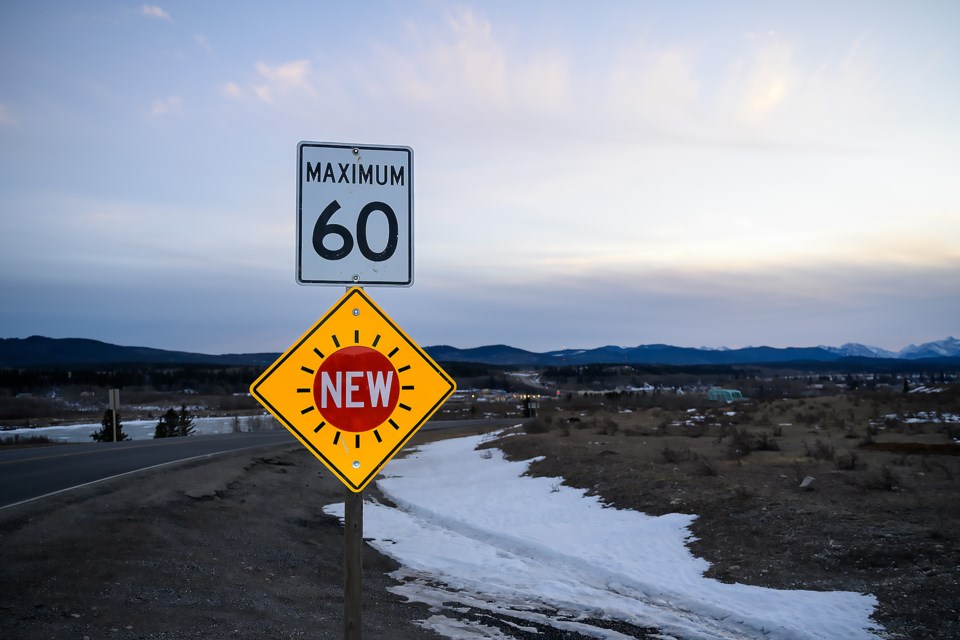ÎYÂRHE NAKODA – A speed limit change on Mînî Thnî Road aims to make the spur route through Îyârhe Nakoda First Nation safer for motorists, pedestrians and animals alike.
Local emergency services successfully advocated for an 80 km/h to 60 km/h speed reduction on Highway 133X, a provincial road that runs through the middle of Mînî Thnî connecting Highway 1A and Trans-Canada Highway, Alberta Transportation formalized the change last month.
“There’s been fatalities over the years with people not slowing down quick enough and having struck pedestrians in that area. It was a concern for school kids and pedestrians crossing the road,” said Nakoda Emergency Services director Reg Fountain.
According to Stoney Nakoda/Kananaskis RCMP, there was one fatal pedestrian death in 2020 near the two crosswalks in the townsite. A 40-year-old female was struck and killed and a 19-year-old female driver from Mînî Thnî was arrested and charged for dangerous operation of a vehicle resulting in death.
“Any reduction in the speed limit is welcome news,” said Sgt. Mike Eady. “The main thoroughfare in the community sees a lot of pedestrian traffic and a lot of traffic pulling off of crossroads.
“In reducing the speed limit on Mînî Thnî Road, it would have a positive impact on those who use the roadway and hopefully decrease the dangers for those who use and walk it daily.”
In the last 10 years, Eady noted there have also been two other fatal motor vehicle collisions on the road resulting in two deaths caused by driver error and losing control and going off the road.
From 2019-23, while the road’s speed limit was 80 km/h, there were also 315 traffic tickets issued for a variety of provincial offences, according to RCMP.
Fountain said discussions to change the speed limit began in August and involved RCMP and the chiefs of Goodstoney, Chiniki and Bearspaw First Nations.
“In talking with RCMP, a recommendation was made to the tribal chiefs that the road’s speed limit be reduced, except in the townsite where the speed limit would remain at 50 km/h. The chiefs agreed and so we made a formal request to the province,” he said.
The speed limit adjustment was necessary to allow more time for vehicles approaching from north and south to slow down entering the townsite, which has two pedestrian crossings next to each other connecting core services like schools and the health centre, and housing on either side of Mînî Thnî Road.
“It needed to be changed for a couple of reasons,” said Fountain. “One, you had a speed limit of 80 km/h right to the [Bow River] bridge, and then it would be 50 km/h on the other side of the bridge and that’s almost immediately where the pedestrian crossings are.”
The speed limit also presented a risk to roaming livestock on the Nation.
“If you have a heavily laden gravel truck coming down the hill into Mînî Thnî [from the south], it’s difficult to be able to stop in time. You’re worried about hitting a pedestrian crossing the street or collisions with livestock,” said Fountain.
Since making the change emergency services have heard some complaints but mostly positive feedback, most notably from Stoney Education Authority, the governing school board for Nakoda Elementary School and Mînî Thnî Community School near the west side of Highway 133X.
“We heard positive response from superintendent Bill Shade that their staff have noticed and really appreciate the consideration to help keep the school kids safe,” said Fountain.
In another other public safety measure, a crosswalk on the Highway 1A – which has no shoulders for pedestrians on either side – was recently sanctioned and installed by Alberta Transportation in October. The crosswalk links the south and north sides of the road, west of the Highway 133X intersection.
New residential development north of the highway was accounting for increased pedestrian traffic in the area and the Nation requested a crossing be installed, said Alberta Transportation spokesperson Wayne Wood in an email.
“When planning the location for the crosswalk, there was a distinct pedestrian pathway visible, which crossed Highway 1A roughly 500 metres west of the intersection. The department consulted with Stoney Nakoda to see which location they felt would be most likely to be used by pedestrians, and the section west of the intersection was the preferred location,” he said.
“The crosswalk is pedestrian activated, with solar powered rectangular rapid flashing beacons. There are also solar powered overhead lights that are activated when the crosswalk is in use.”
The Local Journalism Initiative is funded by the Government of Canada. The position covers Îyârhe (Stoney) Nakoda First Nation and Kananaskis Country.




